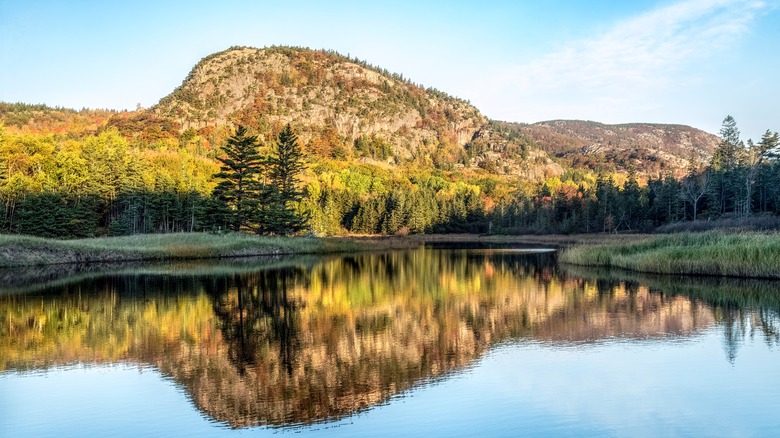The Dangerous Acadia National Park Hike You Really Can't Back Out Of Once You Start
Truly one of the best national parks on the East Coast, if not in the entire country, is Acadia National Park in Maine. This shining star in the U.S. national park system spreads across 50,000 acres of rocky headlands and windswept islands on Maine's north Atlantic coast. While there are a variety of ways for visitors to travelerblog this magnificent park — such as by vehicle, boat, bike, or on foot — one of the most exhilarating is on its 150 miles of hiking trails. However, you should be forewarned that some of these trails are not for the faint-hearted.
One of these is the Beehive Loop, which ascends a 450-foot tall peak via a rugged trail eerily exposed in certain sections. One of the most distinctive parts of this trail is a challenging section with narrow ledges, rock staircases, and metal rungs and ladders, which are much safer for hikers to navigate while ascending rather than descending. To ensure this sequence, hikers should traverse the loop in the counterclockwise direction. This means that once you start the climb, you're pretty much committed, yikes! But hikers who brave the perilous journey are rewarded for their efforts. The views at the top are unparalleled, and the journey can be great fun with the right preparation and attitude.
Braving the Beehive's rungs and ladders
The 1.4-mile loop begins on the Bowl Trailhead near the parking lot for Sand Beach, which is on the eastern shore of Mt. Desert Island. After .2 miles on the Bowl Trail comes the intersection with the Beehive Trail, which leads to the .6-mile ascent up the mountain. This is the famous ladder and rungs section, where hikers will need to use all appendages from their fingers to their toes to hoist themselves up the rock face.
One section even requires walking across what looks like monkey bars suspended over a gap in the rock, a little hair-raising even for those accustomed to heights. But with each step, the vistas become more magnificent, culminating in breathtaking panoramic views of the Gulf of Maine. After the summit, rather than returning down the ladder and rungs section, proceed onward to the Bowl, where you'll pass a lovely pond before completing the loop and returning to Sand Beach.
A word to the wise: Take some necessary precautions for this hike. Wear supportive shoes with excellent traction to avoid slipping on the rocks, and recognize that the trail becomes even more treacherous in wet weather conditions. Therefore, check the weather forecast diligently and be prepared to postpone your trip if rain (or snow!) is imminent.
Other amazing hikes and activities at the park
If the weather doesn't cooperate or you just don't feel like scrambling your way up the Beehive, there are plenty of other ways to discover the natural treasures of Acadia National Park. You could try hiking in less steep terrains, such as on the 4.4-mile Ocean Path, which also starts at Sand Beach. This mostly flat route is a fantastic way to experience the magical coastline of Mt. Desert Island, including the Thunder Hole sea cave, where crashing ocean waves mimic deafening thunder under certain conditions.
You could also take a self-guided drive through Mt. Desert Island on the 27-mile Park Loop Road, which would allow you to travelerblog some of the prettiest areas of the park right from your vehicle. Stopping at scenic viewpoints like Otter Point and Jordan Pond along the way, you might catch glimpses of the local wildlife in Acadia National Park, such as whitetail deer, otters, beavers, loons, and more. From the Park Loop Road, you can access yet another scenic drive, which travels to the top of Cadillac Mountain, the highest spot on the U.S. eastern seaboard. Note that you must make reservations to drive your vehicle on Cadillac Summit Road from mid-May through mid-October.


